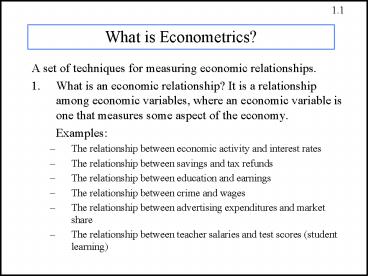What is Econometrics
Title:
What is Econometrics
Description:
What is Econometrics? A set of techniques for measuring economic relationships. ... For applied econometric analysis this consumption function must be specified ... – PowerPoint PPT presentation
Number of Views:80
Avg rating:3.0/5.0
Title: What is Econometrics
1
What is Econometrics?
- A set of techniques for measuring economic
relationships. - What is an economic relationship? It is a
relationship among economic variables, where an
economic variable is one that measures some
aspect of the economy. - Examples
- The relationship between economic activity and
interest rates - The relationship between savings and tax refunds
- The relationship between education and earnings
- The relationship between crime and wages
- The relationship between advertising expenditures
and market share - The relationship between teacher salaries and
test scores (student learning)
2
What is Econometrics ? (cont)
- 2. How do we measure these relationships?
- We use
- economic theory about how economic agents make
decisions - data on the economic variables to model and
estimate the economic relationship
3
Understanding Economic Relationships
money supply
Dow-Jones Stock Index
federal budget
short term treasury bills
inflation
trade deficit
Federal Reserve Discount Rate
unemployment
power of labor unions
capital gains tax
rent control laws
crime rate
4
The Consumption Function
- From economic theory we know that consumption, c,
is some function of income, i - c f(i)
- For applied econometric analysis this consumption
function must be specified more precisely, such
as - c ?1 ?2i
- What is ?2?
- Use econometric techniques to estimate ?1 and ?2
5
Demand Model
Demand, qd, for an individual commodity
qd f( p, pc, ps, i )
p own price pc price of complements ps
price of substitutes i income
If quantity demanded is a linear function
qd ?1 ?2 p ?3 ps ?4 pc ?5 i
6
How Much?
- If we understand the nature of a relationship
between economic variables then we can answer the
how much question - Bernanke asks by how much will economic activity
fall if we raise interest rates by a quarter
point? - CEO of Pepsi asks by how much (if any) will
market share increase if Pepsi increases
advertising expenditures by 100 million? - The Mayor asks by how much will crime fall if
local wages increase by 20?
7
To Answer How Much
- The model is unknown, so
- We theorize about it and
- We use data to test our theories and to make
predictions about how much
8
Constructing an econometric model
- Start with c f(i) but it is too general
- Use theory to argue for c ?1 ?2 i (linear
relshp) - But ?1 and ?2 are unknown
- And there may be other variables that influence
c. (The relationship isnt exact) - Econometric Model
- c ?1 ?2 i e
- (?1 ?2 i) is the average, systematic,
deterministic part. - e is the random error term that measures all
other factors.
9
Econometric Model of Consumption
Actual systematic part random error
c f(i) e
c ?1 ?2 i e
Consumption, c, is a function of income, i, with
error, e
Systematic part provides prediction, f(i), but
the prediction will miss the actual value by a
random error, e.
10
A General Econometric Model
y ?1 ?2 X2 ?3 X3 e
- Dependent variable, y, is focus of study
- (predict or explain changes in dependent
variable).
- Explanatory variables, X2 and X3, help us
explain - observed changes in the dependent variable.
11
Econometric model
- Systematic or Deterministic Portion
- (non-random) economic variables
- and parameters.
- Error Term
- Random variable with a probability
- distribution.
- Data
- observed values of the variables.
12
Research Format
- 1. It all starts with a problem or question
- 2. Economic theory gives us a way of thinking
about the problem What economic variables are
involved and what is the possible direction of
the relationship(s)? - 3. The working economic model leads to an
econometric model. We must choose a functional
form and make some assumptions about the nature
of the error term. - 4. Sample data are obtained, and a desirable
method of statistical analysis chosen, based on
our initial assumptions, and our understanding of
how the data were collected.
13
- 5. Estimates of the unknown parameters are
obtained with the help of a statistical software
package, predictions are made and hypothesis
tests are performed. - 6. Model diagnostics are performed to check the
validity of assumptions weve made. For example,
were all of the right-hand-side explanatory
variables relevant? Was the correct functional
form used? - 7. The economic consequences and the implications
of the empirical results are analyzed and
evaluated. What economic resource allocation and
distribution results are implied, and what are
their policy-choice implications? What remaining
questions might be answered with further study ?
14
Note the textbook uses the following symbol
to mark sections with advanced material
Skippy































